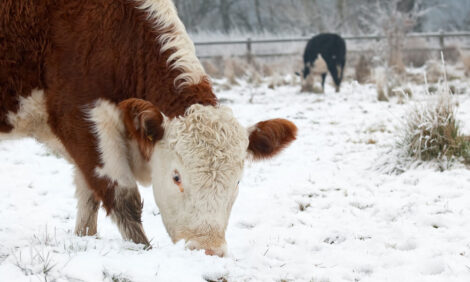



‘Nanobubble marinade’ helps reduce meat, dairy pathogens
Ozone is used to decontaminate meat, poultry and dairy productsAt the USDA-ARS Meat Safety and Quality Research Unit in Nebraska, microbiologists Mick Bosilevac and Nor Kalchayanand, along with supervisory research food technologist Tommy Wheeler, teamed up to examine a relatively new food safety process: spraying beef and pork carcasses with an ozone solution to kill common pathogens, such as E. coli or Salmonella.
“This project was part of a large farm-to-fork project that focused on cattle and swine, following them through harvest and concluding with finished beef and pork products ready for consumers,” Bosilevac said. “During harvest we improved on many processes to help reduce contamination.”
The Centers for Disease Control and Prevention (CDC) estimates that Salmonella bacteria causes about 1.35 million infections, 26,500 hospitalizations, and 420 deaths per year. For Shiga toxin-producing E. coli (STEC), it’s more than 265,000 illnesses each year, with more than 3,600 hospitalizations and 30 deaths. Further, USDA estimates that foodborne illnesses cost the United States more than $15.6 billion each year.
In trying to bring those numbers down, one of the improvements the researchers discovered was that including aqueous ozone (ozone infused into water) in the spray used to rapidly cool beef carcasses immediately after harvest would cover the meat with a natural antibacterial coating.
“Ozone is a naturally occurring water-soluble gas that has an antibacterial property,” Kalchayanand said. “Two major advantages of ozone are that it kills germs and auto-decomposes into a harmless product – oxygen.”
The researchers found that they could make “aqueous ozone” by using a specialized chamber to create nanobubbles in water. The bubbles are about 2,500 times smaller than a grain of salt – so tiny that they can deliver the disinfecting power of ozone into most crevices.
In addition to main cuts of meat, Kalchayanand said that aqueous ozone can be applied to meat trimmings, which are the starting material for ground meats like hamburger and sausage, or even to non-meat foods.
“We can improve the microbiological quality and shelf life of vegetables, fruits, cheeses, eggs, nuts, and poultry when they are directly treated with ozone or stored in an ozone-containing environment,” Kalchayanand said. “Ozone can also decontaminate food-contact surfaces, non-food-contact surfaces, sanitize equipment, recycle wastewater, and decrease pesticide levels on fresh produce.”
According to Kalchayanand, incorporating an aqueous ozone treatment step into the meat harvesting workflow should be an easy process; ozone nanobubble generators are commercially available. Infusing both ozone and hydrogen peroxide to form nanobubbles, combined with existing technologies like infrared and ultraviolet light, may increase meat producers’ overall ability to kill germs.
“Ozone intervention can be integrated in meat processing plants at the proper stages during harvesting,” he said. “This way processors can more easily implement the new treatment (ozone) without having to reengineer portions of their facilities.”
Disinfecting with aqueous ozone is a win-win-win situation, Kalchayanand said. “Ozone kills about 90% of bacteria on the surfaces of meat, leaves no chemical residues, and is good for the environment because it is sustainable and decomposes to oxygen and water.”
TheCattleSite News Desk


